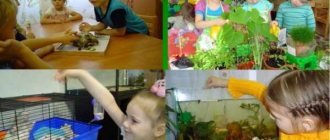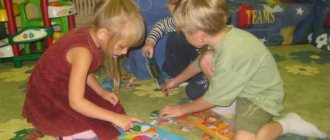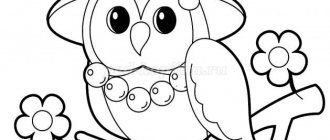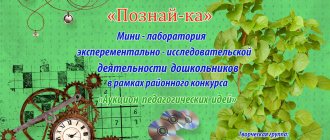How independence is formed and manifested in activities
Independent activity of children is a kind of autonomy. It is understood that the preschooler performs certain actions or solves practical problems without the participation of an adult.
From a theoretical point of view, independent activity requires setting a goal, choosing the means to achieve it, direct implementation, as well as at least minimal control.
Everything looks like a complex algorithm. But in practice it turns into a sequence accessible to the child. For example, looking at cubes or large parts of a construction set, the baby begins to build a tower, similar to the one he built yesterday with his dad. All components of the activity process are present here, but the preschool child himself conceives and implements the idea.
The manifestation of independence does not happen suddenly and instantly. At about 3 years old, the child begins to assert his independence at the everyday level. At first he performs the actions with the help of an adult, but the next step quickly comes when the baby wants to free himself from this help. Every now and then the persistent “I myself!” sounds.
The adult gives the child a model of how to perform the action. Imitation is a child’s primary activity. The preschooler takes independent actions on his own initiative, and he still needs to mature for them.
We can distinguish the stages of development of independent actions, which can be traced in any type of activity that the baby undertakes:
- Joint-shared attempts. They start an activity (drawing, storytelling, any practical activity) together. Then the adult actively helps the child, or even does the main part.
- Performed by a preschooler, but with hints and based on the demonstration of the necessary actions by the mentor.
- The adult proposes, that is, sets a task, and the child copes with it. This stage can be called performing.
- The preschooler himself takes the initiative and performs actions in order to achieve the goal that he sets for himself.
In childhood, the boundaries within which children try their hand are expanding every day. The preschooler begins to show independence in any activity available to him: cognitive, playful, creative, productive.
“Creating conditions for organizing independent activities of preschoolers”
“Creating conditions for organizing independent activities of preschoolers”
Teacher Gerasimova T. A.
A modern educational space must be equipped in accordance with the requirements dictated by the federal state educational standard. The Federal State Educational Standard indicates the need to organize the educational process based on creating conditions for independent activity of children in a preschool institution. And here the skill and professionalism of the teacher is most clearly demonstrated. How to direct each child to a useful and interesting game without suppressing his activity and initiative? How to alternate games and distribute children in a group room or area so that they can play comfortably without disturbing each other? The creative development of every child depends on the ability to quickly solve these issues.
Independent activity has great potential for the development of a child’s personality:
— development of initiative, activity;
— consolidation of existing skills and methods of activity;
— vivid impressions find a way out, tension is reduced, making the child’s inner world comfortable;
- self-esteem, self-confidence, and self-confidence rises.
Scientific research indicates that under conditions of optimal upbringing and training, children can achieve a certain level of development of independence in various types of activities: gaming, communicative, motor, cognitive-research, productive, labor, musical. Thus, these types of activities can and should become independent.
Independent activity of children is one of the main models for organizing the educational process of preschool children:
1) free activity of pupils in the conditions of a subject-specific developmental educational environment created by teachers, ensuring that each child chooses an activity based on his interests and allows him to interact with peers or act individually;
2) activities of pupils organized by the teacher, aimed at solving problems related to the interests of other people (the emotional well-being of other people, helping others in everyday life, etc.).
What should the subject-development environment be like in accordance with the Federal State Educational Standard for Education?
Transformable, content-rich, multifunctional, variable, accessible and safe.
If we talk about the richness of the environment, we assume the presence of activity centers in the group (play, cognitive-research, creative, motor, etc.)
The transformability of the environment implies the possibility of changing it depending on the interests and desires of the children.
The multifunctionality of the environment presupposes the possibility of varied use of objects, attributes, and natural materials.
The variability of the environment presupposes the presence of various spaces (for play, construction, privacy, etc.), providing free choice for children; change of play material, the emergence of new items that stimulate children’s activity.
The developing subject-spatial environment in kindergarten should:
- have an attractive appearance;
- act as a natural background to the child’s life;
- relieve fatigue;
- positively influence the emotional state;
- help the child individually explore the world around him;
- give the child the opportunity to engage in independent activities.
The group space should be organized in the form of well-demarcated zones (“playgrounds”), equipped with a large number of developmental materials (books, toys, creative materials, educational equipment, etc.). All items must be accessible to children.
Such organization of space allows preschoolers to choose interesting activities for themselves, alternate them during the day, and gives the teacher the opportunity to effectively organize the educational process, taking into account the individual characteristics of children.
The equipment of the corners should change in accordance with the thematic planning of the educational process.
Development centers can be centers for:
-for role-playing and director's games;
-for cognitive activity;
-for independent activities of children;
- for physical activity;
-for board-printed and educational games;
-for experimentation and observation of natural phenomena;
for relaxation (solitude, communication, etc.)
The free activity of children in development centers helps them search independently, engage in the research process, and not receive ready-made knowledge from a teacher.
The centers can be demarcated, but at the same time, 1/3 of the group space is free for organizing games and activities for a large number of children.
Furniture and equipment are arranged in such a way as to ensure free and safe movement of children.
“Quiet” and “noisy” centers are sufficiently separated so that children do not disturb each other; designing a “solitude corner” is necessary for the child to relax;
materials that stimulate cognitive and speech activity of children are included in all centers;
materials that allow the child to develop independent activities are presented in sufficient quantities;
centers allow both individual lessons for children and groups of children in small and large groups;
The group room is organized so that educators can simultaneously observe what is happening in most centers.
Considering that the leading activity of preschool children is play, the teacher must create a varied play environment, which should provide the child with cognitive activity, should correspond to his interests and be developmental in nature. At the same time, it should contribute to the development of creative abilities, awaken imagination, activity, teach communication, and vivid expression of one’s feelings.
Play in kindergarten should be organized, firstly, as a joint game between the teacher and the children, where the adult acts as a playing partner and at the same time as a carrier of the specific “language” of the game. The natural emotional behavior of the teacher, who accepts any children’s plans, guarantees freedom and ease, the child’s enjoyment of the game, and contributes to the desire in children to master the methods of play themselves. Secondly, at all age stages, play should be preserved as a free independent activity of children, where they use all the play tools available to them, freely unite and interact with each other, where the world of childhood is ensured to a certain extent, independent of adults.
Along with play, free productive activity of children (constructive, visual, etc.) occupies a significant place in a child’s life. Just like in play, the child’s development opportunities are enriched here.
The teacher can plan in advance the independent activities of children, taking into account the topic that is relevant for a given day (or week), the set goals and objectives of educational work during the day, that is, the principle of a comprehensive thematic structure of the educational process in a preschool educational institution must be implemented. The teacher “starts” from this topic when organizing children’s independent activities.
Thus, the independent activity of children in a preschool educational institution is an activity that is carried out without the direct participation of the teacher, on his instructions, at a time specially provided for this, while the child consciously strives to achieve the goal, using his efforts and expressing in one form or another the result of mental or physical actions.
Preschooler's independence in play
Play is the most natural activity in preschool age and the leading activity in a child’s development. In play settings, children discover themselves and social relationships. A role-playing game is an ideal environment for developing independence.
The adult is present in the child’s play activities, but indirectly, through a role. That is, children see the behavior and attitudes of the adults around them, take them as a model, and then model them in their games.
The play of younger preschoolers is mainly imitation. They try to copy gestures and tonality of statements. They scold “offending” dolls, just like a mother. They show concern, playing the role of a doctor, etc. However, the choice of plot, the selection of substitute objects (what will be a thermometer, and what will be a plate of porridge) occurs independently.
Thanks to the effective embodiment of the role, children acquire work skills in the game. If according to the plot you need to clean the room, then the baby takes on putting away scattered things or sweeping.
With the development of play activity, children show more and more independence. They complicate plots, distribute roles, agree on rules, and themselves control their implementation.
Free activities for children. Independence.
Khvalina Galina
Free activities for children. Independence.
What is independence ? It would seem that the answer lies on the surface, but everyone understands it differently.
Many authors believe:
- this is an action that a person carries out on his own, without prompting or help from others;
- the ability to rely only on one’s own strengths;
— freedom of expression of one’s feelings and creative ideas;
- ability to manage oneself and one’s time;
— the ability to set new tasks and solve them yourself .
It is difficult to argue against these definitions. They accurately indicate human independence . What is included in the concept of “ independent activity ”
.
«Independent activity»
is most fully defined by A.I. Zimnyaya.
According to its definition, “ independent activity is presented as goal-oriented, internally motivated, structured by the object itself in the totality of actions performed and corrected by it according to the process and result of the activity .” Its implementation requires a fairly high level of self-awareness , reflectivity, self-discipline , personal responsibility, and gives the child satisfaction as a process of self-improvement and self-knowledge .”
Thus, “ independent activity , or amateur activity ” is a subjective, strictly individual self-managed activity , with personally determined components: a goal, a leading need, motivation and methods of implementation.
Independence by the child’s intelligence, emotional state, physiological and individual characteristics; a large place is given to equipment.
With the concept of “ independent activity ”
“
self-activation ” is closely related - this is a subjectively correlated internal motivation
for activity .
Of particular importance for development in preschool age is the stimulation and maximum use of motivation to achieve success in children’s educational, work and play activities .
The actual process of independent activity is presented in the form of a triad: motive - plan (action)
- result.
Motive encourages a child to act . It can be created by different conditions:
– enrichment of the arsenal of skills;
– encouraging children through changing conditions;
– setting new tasks.
The main types of children's activities in the preschool period are playful and productive.
There are two types of independent activities of children in kindergarten :
1. Game activity : director's game, role-playing game, games with rules.
2. Productive activities : design, fine arts, manual labor.
The main criterion for assessing the independent play activity of pupils should be play behavior, ways of spreading the game, the child’s ability, depending on his own plan, to include conditional actions with objects, role-playing dialogues, and combine various events into the game.
Play is one of the most valuable new developments of preschool age. While playing, the child freely and with pleasure masters the world in its entirety - in terms of meanings and norms, learning to understand the rules and creatively transform them.
It is the game that should be primarily used by teachers. L. S. Vygotsky defined play as the leading activity in preschool age. L. I. Bozhovich considers it necessary that leading activities constitute the main content of the lives of children .
Thus, the game is a kind of center around which the main interests and experiences of children .
The importance of the game in the development and education of the individual is unique, since the game allows each child to feel like a subject, to express and develop his personality, subjectivity, and initiative.
children's interaction in play is a means of developing their independence .
Theatrical activity is a type of game.
Theatrical activities in kindergarten can organizationally permeate all routine moments: be included in all classes, in the joint activities of children and adults in their free time , and carried out in children’s independent activities . Theatrical activities can be organically included in the work of various studios and clubs; products of theatrical activities (stage plays, dramatizations, performances, concerts, etc.)
may be included in the content of holidays, entertainment and leisure activities.
Theatrical play in children's independent activities : independent children's games reflect characters and plots that excite children .
Thus, children often play Snow Maiden and Father Frost, creating a new world of the New Year holiday in the playroom. Vivid stories, games, round dances, learned in joint free activities of children and adults , in games and activities, also contribute to the emergence of independent theatrical play for children .
Theatrical activities help make the life of children in the group more exciting and varied.
The development of free play activity requires support from an adult.
Moreover, the role of the teacher in the game can be different depending on the age of the children , the level of development of gaming activity , the nature of the situation, etc. The teacher can act in the game both as an active participant and as an attentive observer.
Independent creative activity
Independence in creative activity develops gradually both in simple exercises and when the child becomes involved in artistic activities. At first, careful intervention from an adult is necessary to help with specific operations.
The youngest preschooler is just beginning to master the tools necessary for creativity. Holds a pencil confidently, but draws mostly chaotic lines. Already making some constructions, but only the simplest ones.
The field for the manifestation of creative independence in early preschool age is still gaining diversity. It is presented:
- Drawing
- Making mosaic pictures
- Construction from large parts
At 3-4 years of age there is already interest in independent creative activities. It seems that the baby is engrossed in rolling the car while the mother is putting together a mosaic figure and unsuccessfully trying to get the child interested in this activity. And after some time, the baby himself, albeit chaotically, connects the elements of the mosaic or builds a bridge according to the model. Some children will agree to little help. Others will only accept the suggested name.
In middle preschool age, interest in the musical field intensifies. If earlier children pressed the keys of children's musical instruments and rejoiced at the sound they produced, then by the age of five they are interested in chords. Preschoolers pick up the melody by pressing 2-3 keys in a row and begin to experiment with sounds.
Five-year-old children discover word creation. This is an important stage of speech development - the grammatical structure of speech is formed. What words do children come up with! Moreover, they do this not at the behest of an adult. It's time to encourage your child to write his own stories. An adult can offer a preschooler a series of pictures and ask them to tell a story.
Independent creativity of older preschoolers
Older preschoolers do not need such support for their artistic or design experiments. They prefer to hear feedback only about the result. They plan, select funds, and also carry out their plans without outside help.
Of course, children eventually expect to hear praise. At the very least, support, but not criticism. If a child diligently created his drawing or appliqué, then he wants to receive a positive assessment, and not a remark that not everything was successful.
Negative assessments suppress the need for independent activity of this type. Drawings are not praised - the preschooler loses the desire to draw. If they don’t admire the craft, the child’s interest will fade as well.
The preschooler’s motivation for independent action will not disappear; it will manifest itself in other areas. However, it is important for adults to take into account that creativity should not be taken risks and that it is worth supporting the preschooler.
A fairly high level of speech development in older preschoolers opens up primary literary creativity for them. They make up their own stories and rhyme words. Such exercises are characterized by a high degree of independence. If an adult asks a 5-6 year old child to compose a fairy tale, he will most likely refuse. It’s another matter if this impulse comes from within, and the preschooler himself decided to come up with an amusing story.
The goals of writing can be different - to fantasize about what you want, to repeat a memorable plot with a focus on your life, to make your loved ones or friends laugh. In any case, such creativity perfectly develops speech and imagination, and also forms creative initiative.
Calendar-thematic plan of educational activities in the middle group
ReceptionIntroductory conversation
"Fight or Negotiate"
Goal: to develop children's communication skills in various life situations.
Sedentary game
"Find what's hidden."
Objectives: Increasing the motor activity of children, consolidating the ability to navigate in space, move in accordance with the instructions of the teacher, understand constructions using the prepositions “under”, “on”, “in”, “behind”, “about”, “next to”, “ between”, correctly form phrases using these prepositions. Form the grammatical structure of speech, enrich motor and gaming experience
Morning exercises “Fun Exercises”.
Goal: Development of coordination of movements, attention; formation of a positive emotional attitude.
Individual work:
“Breakfast in kindergarten” (Dasha, Artem, Vanya)
Objectives: Formation of cultural and hygienic skills in children, compliance with the rules of behavior at the table.
Reading
Hungarian folk tale "Two Greedy Little Bears".
Tasks: Repetition of the most interesting, expressive passages from the fairy tale, explaining to children the actions of the characters and the consequences of these actions
Walk:
Monitoring the work of the janitor.
Goal: Development of curiosity.
P/N: “Ribbon Trap”
Goal: Development of coordination of movements.
Individual work. Development of movements. (Maxim, Roma, Ksyusha)
Goal: to promote the development of motor skills.
Labor assignments: Cleaning the territory of the group site from inflated debris.
Afternoon:
Health-improving gymnastics after sleep:
walking along a ribbed path.
Conversation “Secrets of Friendship”
Goal: Developing an understanding of the feelings and actions of other children.
Game
-trip “To the Land of Kindness”
Purpose: Consolidating knowledge about kindness, teaching children different ways to express kindness
to your loved ones.
Playing out a game situation: “A guest came to our group”
Goal: fostering friendly relationships between children
Music game
"The Bear and the Hare"
Goal: Developing children's understanding of the nature of music, selecting movements that correspond to it.
DI.
“Why is it necessary?”
Purpose: Exercise children in correctly pronouncing the sound “Ch” in various words
Conversation
"What good have I done"
Goal: To focus children's attention on various events, to invite them to evaluate the actions of their comrades, to teach them to treat each other sensitively and kindly.
Games of children's choice.
Walk:
Weather observation
Purpose: Comparison of morning and evening weather. Formation of the ability to see the beauty of nature; development of observation skills.
Continue work started in the morning.
Independent activity: games with external material.





